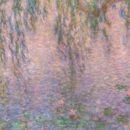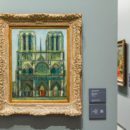The Musée de l’Orangerie was by far one of my favorite museum experiences in Paris. It is hard for an exhibit to be both simple and overwhelming but Monet found a way in this Water Lilies exhibit that featured only four paintings per room. You felt like you were submerged in the art and each room of the exhibit seemed to convey a different look at a very similar idea.
Offered to the French State by the painter Claude Monet on the day that followed the Armistice of November 11, 1918 as a symbol for peace, the Water Lilies are installed according to plan at the Orangerie Museum in 1927, a few months after his death. This unique set, a true “Sixtine of Impressionism”, in the words of André Masson in 1952, testifies to Monet’s later work. It was designed as a real environment and crowns the Water Lilies cycle begun nearly thirty years before. The set is one of the largest monumental achievements of early twentieth century painting. The dimensions and the area covered by the paint surrounds and encompasses the viewer on nearly one hundred linear meters which unfold a landscape dotted with water lilies water, willow branches, tree and cloud reflections, giving the “illusion of an endless whole, of a wave with no horizon and no shore” in the words of Monet. This unique masterpiece has no equivalent worldwide.
The downstairs of the museum has a more familiar layout in size and scope and while not as overwhelming very well done and less crowded than other museums in Paris. The collection is small but that shouldn’t take anything away from the over all experience.
Musée de l’Orangerie shouldn’t be missed and being both on the museum pass and close to the Louvre that shouldn’t be a problem.

























